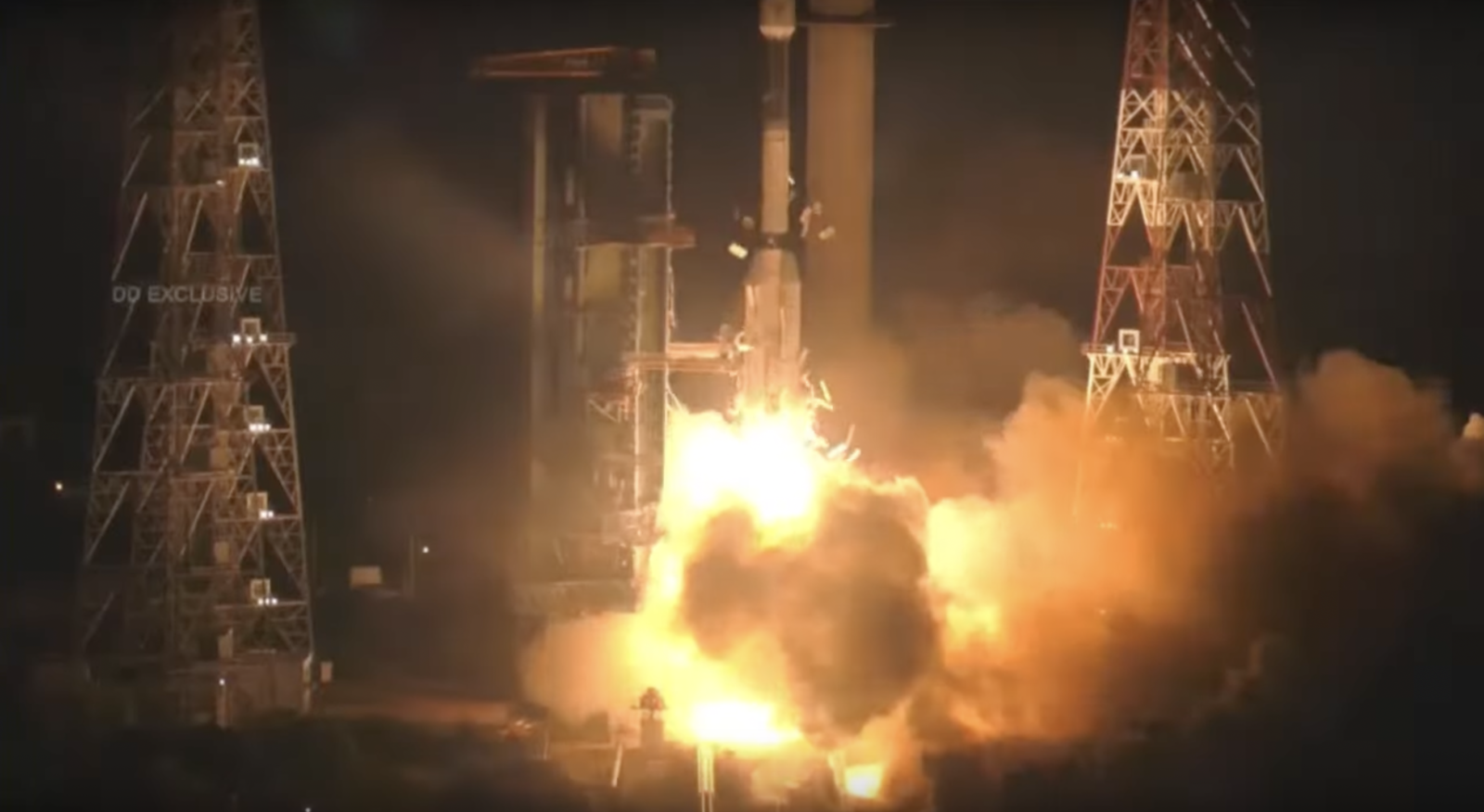
The GSLV F10 lifts off from Sriharikota, at 5:43 am on August 12, 2021. Photo: Doordarshan/YouTube
- The GSLV F10 mission intended to launch the GISAT-1 Earth-observation satellite into the geosynchronous transfer orbit.
- ISRO has attributed the failure to an “anomaly” in the rocket’s uppermost stage, which uses a cryogenic engine.
- It’s important for ISRO to get its operations of the cryogenic engine right, if the organisation is to execute heavier launches of more sophisticated satellites into higher orbits.
The Indian Space Research Organisation’s (ISRO’s) second mission of the year – to place an Earth-observation satellite by a GSLV rocket – has failed. The space agency confirmed on Thursday morning that the cause was the rocket’s cryogenic engine didn’t perform as expected.
The 51.7-metre tall Geosynchronous Satellite Launch Vehicle (GSLV) lifted off lifted off from the second launch pad at the Sriharikota spaceport as planned at 5:43 am on August 12, after the usual 26-hour countdown.
The mission was designated F10/EOS-03. F10 is the mission sequence designation and EOS stands for ‘Earth observation satellite’.
Ahead of liftoff, ISRO’s Launch Authorisation Board cleared the decks for a normal lift-off. The rocket’s first and second stages also performed normally, according to scientists at the Mission Control Centre.
But minutes later, the scientists were seen in discussion, and the range operations director subsequently said the “mission could not be accomplished fully due to performance anomaly” in the “cryogenic stage”.
The rocket stages, including the cryogenic engine, and the payload are expected to have crashed into the Andaman Sea 10 minutes after liftoff, according to astrophysicist and spaceflight tracker Jonathan McDowell.

ISRO currently operated two versions of the GSLV rocket. A previous version, the MK 1, is no longer in use.
All three versions have the same overall flight scheme: three stages, using solid, liquid and cryogenic fuel.
The first stage of the GSLV Mk 2 also has four strap-on boosters that use liquid fuel. The F10 mission used the GSLV in its Mk 2 configuration.
In terms of design and hardware, however, the Mk 2 and the Mk 3 configurations are very different.

After the range operations director confirmed the launch had failed, ISRO chairman K. Sivan added that mission couldn’t be “fully accomplished mainly because there is a technical anomaly observed in the cryogenic stage.”
The F10 mission was carrying the GISAT-1 Earth-observation satellite, capable of near-real-time imaging of large area regions at frequent intervals, monitoring of natural disasters and other episodic events, obtaining spectral signatures for agriculture, forestry and water bodies.
Before today’s launch, ISRO had launched Brazil’s Earth-observation satellite Amazonia-1, plus 18 co-passenger satellites, in February 2021 onboard a Polar Satellite Launch Vehicle (PSLV). The F10 launch was earlier supposed to happen by May, but had to be postponed due to the major COVID-19 outbreak earlier this year.
While the PSLV has often been called a “workhorse” and which ISRO has used repeatedly to execute “textbook launches”, the organisation has had relatively less success with the GSLV rockets.
In fact, the F10 mission’s failure also ended a 16-mission streak of successes for ISRO.
The GSLV’s primary purpose is to launch satellites into the geosynchronous transfer orbit (GTO), an elliptical orbit around Earth that connects the low-Earth orbit to the geosynchronous orbit.
Once a satellite is released into the GTO, it uses its own on-board engine to manoeuvre itself into the require position in the geosynchronous orbit.
Because the GTO is higher and because the satellites that are typically placed there are heavier, the PSLV can’t launch them. The GSLVs can because they use cryogenic engines for the launch’s third and uppermost stage.
For example, the GISAT-1 satellite on-board the F10 mission weighed 2,268 kg – well above the PSLV’s upper limit of 1,500 kg.

Cryogenic engines combust liquefied hydrogen and liquefied oxygen to generate more thrust than other fuels thanks to the chemical properties of hydrogen.
However, these engines are hard to handle because hydrogen and oxygen are both very reactive. They can also been cooled only cryogenically – using liquid nitrogen as a coolant. And in liquefied form, they need special pumps and piping to move them from the tank to the engine.
It’s important for ISRO to get its operations of the cryogenic engine right, if the organisation is to execute heavier launches of more sophisticated satellites into higher orbits.
Spaceflight Now reported:
The circumstances of the GSLV failure resemble an upper stage malfunction that struck a GSLV mission in April 2010. On that mission, the third stage engine’s fuel turbo pump failed about one second after ignition.
One set of launches concerns ISRO’s highly anticipated Gaganyaan indigenous human-spaceflight mission. These missions are expected to use the more powerful GSLV Mk 3 rocket.
Unlike the Mk 2, the Mk 3’s first stage of two solid-fuel engines are strapped to the sides of the second stage. ISRO scientists have developed a semi-cryogenic engine, dubbed SCE-200, based on designs of the Ukrainian RD-810 engine, for the second stage in future launches.
SCE-200 combusts kerosene with liquefied oxygen. There had been speculation that it could be used on Gaganyaan flights, but due to the COVID-19 epidemic and other delays, ISRO has said Gaganyaan won’t use the engine.
When the Government of India sanctioned Rs 10,000 crore for the Gaganyaan mission in 2018, there had been speculation that Prime Minister Narendra Modi would be able to discuss its first mission (expected to be successful) on Independence Day 2021 – this Sunday.
With the F10 flight, ISRO had also hoped to start getting back to its regular launch schedule, which the epidemic had disrupted. According to Hindustan Times, Jitendra Singh, minister of state for the Department of Space, had said ISRO has been asked to retry the launch at a later date.
(With PTI inputs)

